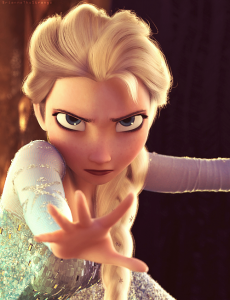
Animated Disney films (such as The Little Mermaid or Beauty and The Beast) are notoriously known for depicting female princesses as powerless, rudimentary anti-heroines that must be saved from an oppressive villainous figure. These cookie-cutter princesses all face a shallow impending crisis that throughout the course of 90 minutes is resolved. The various crises are resolved when the princess falls in love with a man, gets rescued by her prince charming, receives a kiss, or gets married. In the end, the princesses are always saved by a man and live ‘happily ever after’. On itssurface, Frozen appears to be a sharp contrast to these undoubtedly sexist Disney precursors. It is evident that a man does not rescue the protagonist princess Elsa from the crisis that she faces. Additionally, there is a greater majority of lines spoken by female characters than in other Disney princess films. This fact is insignificant because most Disney princess movies pass the Bechdel test1 (this is a nugatory accomplishment because any movie aimed at a young girl should, at a minimum pass).
What makes Frozen more disquieting than previous Disney films is that it elicits the viewer with a false sense of feminist-heroism. This false sense of feminism is perpetuated by the fact Frozen does not have an easily identified villain that unequivocally attacks, suppresses, or manipulates princess Elsa. The ‘villainous’ character (prince Hans) is a mere decoy because he has no significant role in Elsa’s life. Elsa is arguably the most self-thinking and nondependent Disney princess. But, unlike all prior Disney princesses, Elsa is the villain who mistreats herself and others. In fact, Elsa is such a horrible human being only she can save the world from the treachery she causes.
At the beginning of the film, Grand Pabbie (the king troll) warns Elsa of the innate potential of her magical powers, “There is beauty in your magic…But also great danger.” Grand Pabbie knows only Elsa can choose to use her powers for beauty or destruction. Because of this, Grand Pabbie tells Elsa that she must learn to control her powers. He scares Elsa by showing her what will happen if she “panics” the townspeople of Arendelle: she will be attacked in witch-hunt fashion. Out of fear that her powers will be used for evil, Elsa’s parents isolate her from society so that she is unable to hurt anyone. Elsa is locked away in her castle similarly to how Belle is locked away in the Beast’s castle. Her forced isolation causes her to become fearful, angry and sad. After her parents die, Elsa chooses to continue to live in isolation because she believes her powers are a danger to others and can only be used for evil. She believes that her powers can only be used for evil. Elsa feels an immense pressure to be a ‘good girl’, so she ‘conceals’ her magical powers by isolating herself because she is unable to control her powers.

The roman numerals (MDCCCXL) in the top left corner of a map of Arendelle determine that Frozen takes place in a fictional 1840’s Scandinavian society (1). This is important because in 19th century Europe there was no real fear of female being accused of engaging in witchcraft. Thus, Elsa did not live in fear of being stoned to death because it wasn’t simply wasn’t the reality of the time. If she knew how to control her powers and use them for good, she would not live in isolation. In fact, at the end of Frozen, the township of Arendelle warmly embraces her ‘magical powers’ when she uses them for good. The only probable reason Elsa hides from the world is because she does not know how to use her powers for nondestructive acts.
As princess, Elsa decides to permanently keep the gates of her Kingdom closed in a North Korean-like fashion. It does not cross her mind that this selfish act causes the people of Arendelle to suffer, including her sister. There was no need for Elsa to isolate Arendelle from the rest of the world because she considers herself, rather than an external enemy a preeminent threat to Arendelle. She is forced to open the gates of Arendelle on her coronation day, two townspeople discourse: “I can’t believe they’re finally opening up the gates” “And for a whole day!” (Lee 13). As soon as Elsa becomes the queen, she recloses the gates of Arendelle. She then runs away after unleashing a permanent winter on Arendelle; which subsequently forces the townspeople to live in treachery.
Elsa believes that her powers are the result of an evil curse that has been cast upon her and that she ‘can not control the curse’. In her new castle made of ice, Elsa declares that she is finally free and happy because she has stopped trying to control the evil curse she believes to be inside of her. In fact, she purposely ‘lets the storm rage on’ and warmly embraces the evil powers inside of her. She is no longer pressured to ‘be the good girl [that] she always had to be’. With her newfound freedom she ‘tests the limits’ because there are ‘no [longer] rules for [her]’. The fears that Pabbie instilled in her, “can not get to me at all”, she exclaims! ‘The cold never bothered her anyways’, and all that matters to her now is that she’s happy. Elsa has been waiting her whole life to finally be free. Now that she is free she, unleashes her powers (which she knows are evil), and she is “never going back” because she does not care. In her kingdom of isolation, Elsa is the queen. In Kim Jung-Il’s kingdom, he’s the ‘supreme leader’. She does not care that the people of Arendelle are suffering as a result of her actions. Elsa does not care that Arendelle is literally ‘frozen’—not unlike Dante’s treachery.
It must be noted that she was not born inherently evil but rather, she became evil due to her forced isolation. Simply put, Elsa chooses to be evil. This actuality is made clear in the opening scenes that explicitly state that Elsa was born with her powers. This is important because, the movie resolves when Elsa is forced to confront the destruction that she has caused.
In the song, Do You Want to Build a Snowman?, Anna twirls around a painting of Joan of Arc and tells Joan to “hang in there”. The movie forces the connection that similar to Joan; Anna is a heroine who must fight against a regime to save her homeland. It is up to Anna to stop Elsa in order to save Arendelle. Anna attempts to confront Elsa and “save Arendelle from destruction”, Elsa strikes her with an icicle and unleashes a menacing snowman after her to kill her. Elsa realizes that she killed her sister, and begins to hug her frozen corpse. Elsa’s ability to freeze things becomes her ability to thaw. When she finally shows compassion towards someone, she literally ‘thaws her frozen heart’. This act of affection, causes Elsa realize she can choose to use her powers how she pleases—for good or for evil. In fact, she saves her kingdom by loving them rather than oppressing them.
Throughout the course of her life, Elsa was affected and became an evil human being who was abusive of her powers. Frozen is not at all about a strong, female role model. Elsa is an evil-hearted princess who young girls should not aspire to be. Because Disney movies must end with a ‘happily ever after’, Elsa magically decides to stop being evil. But, like the movie repeatedly states, “the heart is not so easily changed, but the head can be persuaded.”. Elsa is magically able to reverse her malicious sprit, but in reality, this is much harder to do. People who are innately evil, are not easily persuaded to become nice. In fact, the movie states this: “the heart can not be easily changed”. It is only because Disney movies end in a happily ever after, she decides to use her powers for good. For someone to not be mean spirited, they mustn’t become evil in the first place. The ‘happily ever after’ that Elsa receives, helps to blur that fact that Elsa is not a good human being. Perhaps, Disney should have given her squinty eyes like they did to all their other villains.
1 The Bechdel test asks a work three basic questions: 1) Does it has to have at least two women in it? (2) Do they talk to each other? (3) Do they talk about something other than a man? Read more about the Bechtel test.
Photographs from:
